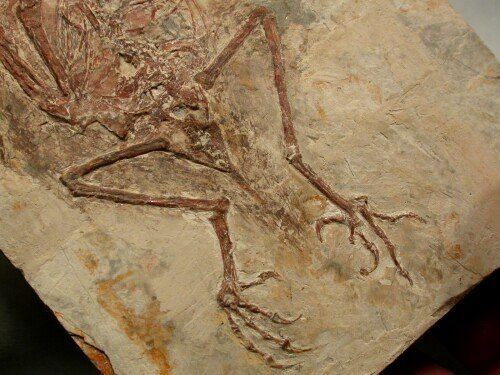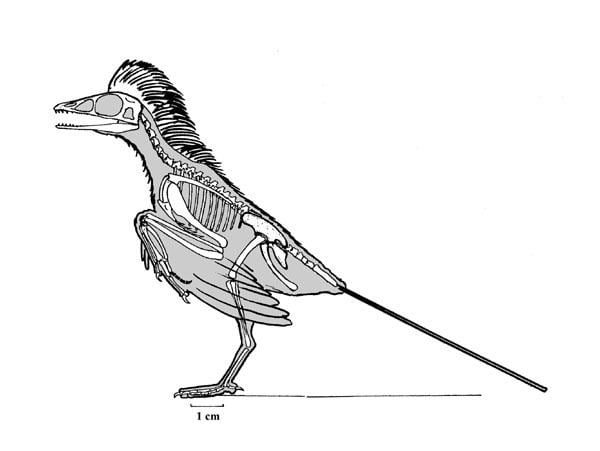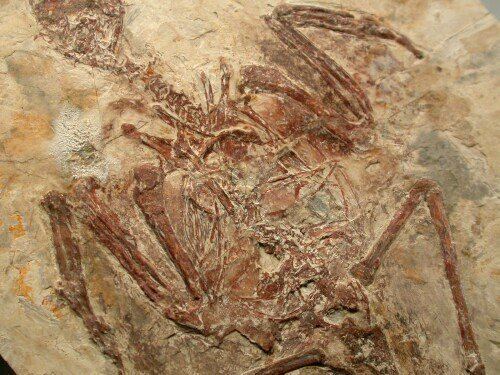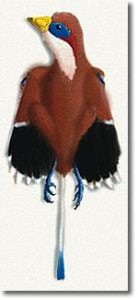Rank Genus | Phylum Chordata Species †P. fengningensis | |
 | ||
Order †ProtopterygiformesZhang & Zhou, 2006 Family †ProtopterygidaeZhang & Zhou, 2006 Similar Boluochia, Cathayornis, Eoenantiornis, Longipteryx, Liaoxiornis | ||
Protopteryx is an extinct genus of bird and the most primitive enantiornithine, from the Cretaceous period. The type species is P. fengningensis. It was first discovered in the Sichakou Member of the Yixian Formation of Hebei Province, northern China, dating from 131 Ma ago. Protopteryx has been found in the Daibeigou formation, as well. The name Protopteryx means "primitive feather": "proto-" meaning "the first of" and "-pteryx" meaning "feather" or "wing." The name comes from the fact that Protopteryx feathers have features of modern ones as well as of reptilian scales, such as the two elongated tail feathers that lack barbs and rami.
Contents
- Description
- Classification
- Discovery and geography
- Paleobiology
- Adaptions of feathers
- Evolution of feathers
- References

Description

Protopteryx fossils show that they were roughly the same as a today's starling. The adult body length of the Protopteryx was about 10 centimetres (3.9 in), excluding the tail feathers. Protopteryx teeth were conical and unserrated, and some teeth had a resorption pit similar to those seen in Archaeopteryx. The body of the Protopteryx was covered in three types of feathers: down feathers, flight feathers, and long, ribbon-like tail feathers. The body was mostly covered in feathers of about 12 millimetres (0.47 in). The barbs of the down feathers were laminar instead of hairlike and were frayed at the tips. The most distinctive feature of the Protopteryx is that the tail consisted of two long feathers which only had barbs at their tips. Closer to the body, the long tail feathers were thin and needle-like. The only modern birds to share a feather type similar to the Protopteryx is the red bird-of-paradise. The tail feathers also lack rami on the proximal end of the tail.
Classification

Protopteryx is one of the most primitive known members of the group Enantiornithes. It appeared after Archaeopteryx, one of the most primitive birds, and Confuciusornis. Protopteryx is related to, but is more primitive than, the species Eocathayornis, Paraprotopteryx, and Confuciusornis
Discovery and geography

Protopteryx was discovered in the Sichakou Member of the Hebei province, west of the Liaoning province. The formations where Protopteryx was found were the Yixian and Dageibou formations. The Sichakou Basin is part of the Daxinganling-Taihangshan Tectonomagmatic Belt and moves in a north-northeast direction. When Protopteryx was alive, the Sichakou basin was located at the Hongqiangou-Jiecangou.
Paleobiology
Protopteryx lived in the Jehol Biota in the Cretaceous period, which contains many of the terrestrial and freshwater vertebrate clades. The teeth of the Protopteryx are similar to Archaeopteryx, suggesting a similar diet.
Adaptions of feathers
Protopteryx was adapted for flying and had feathers with features similar to modern birds, as shown by their procoracoid, carina of the sternum, external tuberosity of the humerus, and deltoid crest. These features suggest Protopteryx had modern musculus supercoracoideus and pectoralis. Protopteryx also share asymmetric wing flight feathers with flying birds, as well as Archaeopteryx and Confuciusornis. Tail feathers of Protopteryx have different features to their other feathers: lack of barbs and rami close to the body. The lack of barbs suggests the feathers have a use outside of flight, such as display, thermoregulation, or sensory usage.
Evolution of feathers
Feather evolution is believed to have evolved by: elongation of scales, development of central shaft or rachis, differentiation of vanes into barbs, and appearance of barbules and barbicels. Protopteryx fossils show that feathers evolved with aerodynamics first before being adapted for other reasons. However protofeathers in theropod dinosaurs have indicated that feathers were first used in thermoregulation and displays with flight in birds being an exadaptation. The dinosaur endothermic hypothesis, however, has no support for endothermy in early birds. The different type of the tail feathers seen in Protopteryx suggests a specialization of ancestral feathers, evolved after the common type of feather seen in Archaeopteryx. The origin of avian feathers is being researched and still debated.
